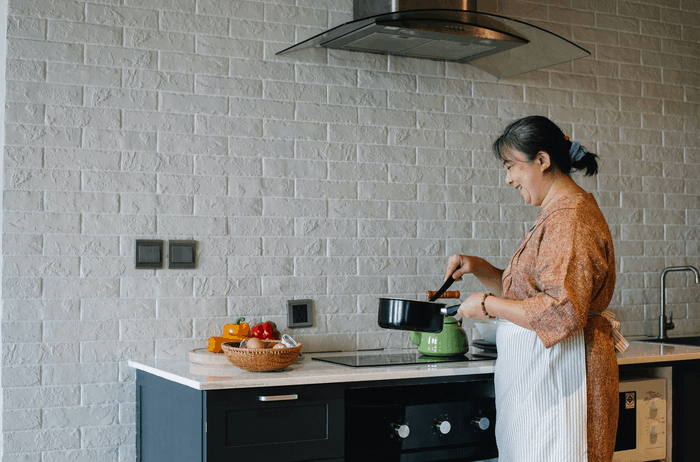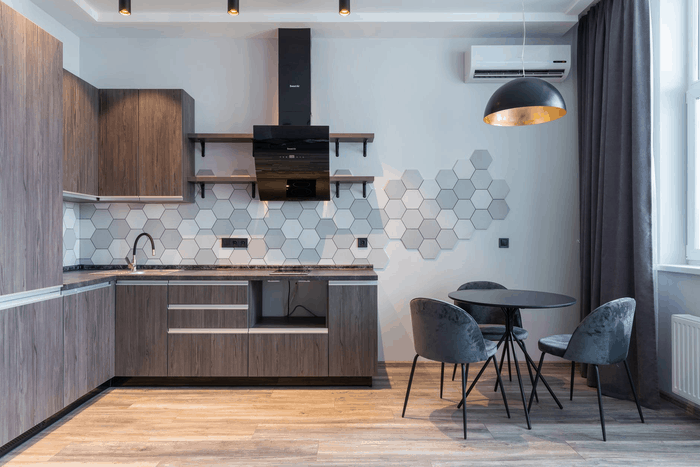How Does a Range Hood Work
Range hoods are electronic equipment that is installed over the cooktop to remove hot and odorous gases. There are two types of range hoods: ducted and ductless. Ducted range hoods extract heat gases from your food preparation and vent them outside your home while allowing fresh, cool air to enter. The hot gases are simply recirculated in ductless range hoods.

What is a Range Hood
A range hood is a household appliance that removes smoke and other chemicals from your kitchen air before venting it outside your house. Range hoods for the home come with several CFM ratings. The majority of suburban hoods have a CFM range of 400-1800. However, range hoods with less than 400 CFM are available. If you are a serious cook searching for a hood with a lot of power, 2000 CFM could be the answer.

Ducted and ductless are the two most common varieties. Ducted range hoods circulate air into ductwork that will pass into the wall or roof and out the front door. This is the most powerful solution in your household because it filters out all of the grease, dust, and contaminants in the air.
In comparison, ductless hoods recirculate the kitchen air through a filter. While it will collect any grease and ashes, the same air will spread in your house. Ductless hoods are ideal for use in hotels, and other homes where ductwork cannot be mounted. If at all possible, buy a ducted hood instead of a ductless hood if you cook often or a lot of Asian-style foods.

Residential range hoods have a maximum airflow of 2000 CFM, while industrial range hoods have a maximum airflow of 5000 CFM or more. They are either operated by a traditional 120-volt outlet or by being hardwired into the kitchen’s electricity network.
Most range hoods are made up of many pieces that work together to clean the air in the kitchen. Light, filters, the speed selector switch, the duct machine, and the blower were among them. Single motor powers most range hoods and vent hoods. Some may have two or even three. These blower motors pull gases and cooking exhaust from above your cooktop and transport it to the outside of your household through ductwork (or through charcoal filters with ductless models).
Components
This post explores how a range hood operates by examining the various components and functions. Keep reading to find out more!
The Duct
The duct (or vent) in ducted range hoods, is responsible for driving hot gases from the cooktop out of the kitchen. The hot gases rise and are drawn in by the electric fan, then guided into the duct, where they are lost to the outside. In situations where they are placed on the wall’s surface, they are normally made of stainless steel.
They should be made of PVC if they are to be built into the walls. Because a ductless range hood depends on an electric fan to cool the air around the cooktop, you may have to depend on the air con to some degree because the ductless range hood does not efficiently keep it cool.
Electric Fans
A range hood’s electric fan, whether ducted or not, is responsible for removing hot gases from your cooktop. When the range hood is turned on, the fans start spinning, sucking hot gases as well as smoke particles into the range hood using the Bernoulli theory.
The performance and sound levels of the range hood are determined by the speed at which the electric fans spin. A 200 CFM range hood is more powerful and noisier than a 150 CFM range hood. Given the increased blowing rates, more modern range hoods now have noise cancellation technology, and some are entirely quiet.
The Filter
The hot gases from the cooktop are sucked through the filters by the electric fan. These catch dust and grease bits, leaving the stove and pans tidy. First, before the fan recirculates the air back into the building, ductless range hoods contain charcoal filters to remove particulate matter and grease from the hot gases.
Clean the range hood filter every 3 months for better and longer range hood performance. This is because if you don’t scrub it, the filter will get congested with grease, and the air will not be properly filtered. You can also face higher electricity bills as a result of the clogged filter, which forces the electric fan to push extra.
Selector Switch
A selector switch panel is used on all range hoods, and it includes an ON or OFF button, control speeds, and a switch to turn the lighting on and off. Earlier range hoods have a manual selector switch screen, but newer improved versions can be controlled remotely.
If the remote sensor fails, they have a manual control panel to use. The height of the range hood over the cooktop can be raised or lowered using remote control on certain more sophisticated range hoods. The range hood’s usefulness is also determined by the distance between the cooktop as well as the bottom of the hood.
The Lighting
A few range hoods include a lighting system that illuminates the cooktop, particularly the more sophisticated models. This is advantageous because it allows you to see the food as it cooks, eliminating the risk of trying to burn it. This also implies you will save a great deal of money and you won’t have to switch on the lights in the kitchen.
Rather, the range hood lighting will suffice. Auto lighting is also available on more modern range hoods, and some also have lighting level memory, so you don’t have to keep resetting every moment you cook.
Advantages of a Range Hood
A range hood can effectively clean the air. Grease, dust, smoke, and other contaminants are continuously generated in your home as you cook. These can pile up in your kitchen without a hood, resulting in low indoor air pollution. The amount of air your range hood can transfer, or CFM, will be determined by your cooking method.
A range hood is not only efficient, but it is also a stunning addition to every kitchen. A range hood can be a bold statement item, or you can opt for a more understated look with a hidden range hood insert. In any case, the latest kitchen upgrade would be a brilliant way to start a discussion.
Working of a Ducted Range Hood
Range hoods with ducting transport the air from your kitchen to the exterior of your house. This means that the indoor air quality is excellent. To the outside, the duct may be run vertically or horizontally. To prevent outside soil, dust, water, and contaminants from piling up within the duct, it’s normally topped off with a roof or wall cover.
Working of a Ductless Range Hood
Air is filtered by charcoal filters and recirculated back into the kitchen with recirculating or ductless range hoods. The charcoal filters catch certain chemicals and do a fair job of odor neutralization. However, it won’t catch any of the toxins, but if at all necessary, go for a ducted range hood.
Working of a Commercial Vent Hood
An industrial range hood functions similarly to a domestic range hood. Within the range, the hood is the blowers. They drag smoke and filthy air out of the kitchen or cooking area through the hood, ductwork, and out space. CFM is the main distinction between industrial and apartment building hoods.
Although most residential range hoods draw between 600 and 1800 CFM of air, commercial hoods can reach 5000 to 6000 CFM and even higher. Commercial hoods will often need greater diameter ductwork to properly vent the air. Restaurants use commercial range hoods and customers cook for long periods.
Working of a Convertible Range Hood
Convertible range hoods can go from ducted to ductless operation. The most common style of hood is the ducted hood. There aren’t many ductless hood choices, but a convertible hood allows you more choices when it comes to selecting the best range hood for your home. If you want the look and consistency of a ducted hood but want to mount it as a ductless hood, they are a perfect choice.
Working of a Microwave Range Hood
Microwave range hoods have fans that either vent air to the outside or recirculate it in your kitchen via ductwork. Microwave range hoods usually have a CFM rating of 300 to 400, which isn’t much for venting smoke and grease outside the kitchen.
Working of a Downdraft Range Hood
Fans mounted behind the kitchen range are known as downdraft range hoods. They filter the air and suck it down into a duct or inside the vent. The air is then recirculated into your kitchen. If you’re not cooking, several downdraft ranges can be taken out of the kitchen range and replaced. They aren’t as effective as traditional updraft range hoods, which trap cooking fumes rising from your pots.
In conclusion, range hoods are available in a variety of styles, colors, materials, and fan speeds. Numerous aspects influence your range hood selection, including your spending plan, the amount of cooking you do, the layout and scale of your kitchen, and your personal taste and tastes. I hope you enjoyed reading this article!
If you do a lot of heavy-duty cooking, for instance, you’ll need a ducted range hood with a higher fan speed, whereas a smaller combination would need a ductless range hood because duct operation would be difficult. Do you have any thoughts and queries about today’s blog? Let me know in the comments section below!
